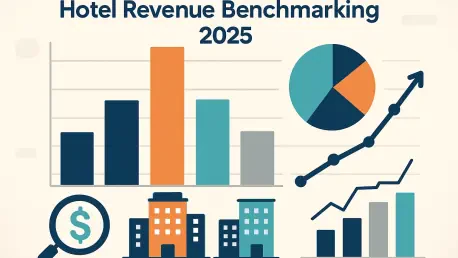In the ever-competitive hospitality landscape of 2025, imagine a hotel struggling to fill rooms during peak season while competitors nearby are booked solid at premium rates, highlighting a critical challenge. The inability to anticipate market shifts can cost millions in lost revenue, especially with global travel demand fluctuating and digital booking platforms intensifying price wars. Hoteliers must adopt innovative strategies to stay ahead. This market analysis delves into how forward-looking benchmarking—a data-driven, predictive approach—offers a transformative solution for boosting revenue. By examining current trends, actionable data, and future projections, the focus shifts to empowering Revenue Managers, Sales & Marketing teams, and Executives to optimize key metrics like Average Daily Rate (ADR) and Revenue Per Available Room (RevPAR).
Decoding Market Dynamics in Hotel Performance
Current Trends Shaping Hospitality Benchmarking
The hospitality sector today is marked by a rapid pivot toward technology-driven decision-making. Traditional benchmarking, rooted in historical data, remains prevalent but increasingly obsolete as it fails to predict sudden demand surges or economic downturns. Real-time data from online travel agencies and booking platforms reveals that hotels relying solely on past performance metrics often miss out on pricing opportunities, resulting in suboptimal occupancy rates. Industry reports indicate that nearly 60% of hoteliers still use outdated methods, highlighting a significant gap in adopting modern tools. This lag creates a market where proactive players can capitalize on predictive insights to gain a competitive edge.
Predictive Analytics as a Revenue Driver
Diving deeper into market shifts, predictive analytics stands out as a dominant force reshaping revenue management. Forward-looking benchmarking tools provide insights into future demand patterns, enabling hoteliers to adjust pricing strategies ahead of high-demand periods like major conventions or holiday seasons. Data suggests that properties leveraging such analytics can achieve revenue increases of 10-15% during peak times by setting optimal rates early. Despite challenges like data accuracy concerns, the ability to anticipate market behavior—rather than react to it—positions these tools as indispensable for maximizing RevPAR and maintaining market share in a volatile environment.
Competitor Analysis Through Dynamic Sets
Another critical trend influencing hotel performance is the evolution of competitor sets, or compsets, in benchmarking practices. Static compsets, often based on outdated criteria, skew results and lead to misguided strategies. Modern tools allow for dynamic, customizable compsets that reflect real-time market conditions, ensuring comparisons are relevant. For instance, a boutique urban hotel can benchmark against similar niche properties rather than broad, unrelated competitors. This tailored approach uncovers specific areas for improvement, though over-customization risks narrowing focus excessively. Still, the precision of dynamic compsets offers a clearer path to enhancing competitive positioning.
Granular Data for Targeted Decision-Making
Beyond broad trends, the market is seeing a surge in demand for granular, actionable data tailored to diverse roles within hotel operations. Sales & Marketing teams benefit from knowing projected demand spikes to launch targeted campaigns, such as weekend getaway packages during anticipated slow periods. Regional variations also play a role—coastal resorts might prioritize seasonal leisure trends, while city hotels focus on corporate bookings. The shift toward detailed insights over generic reports ensures that decisions across property types are evidence-based, reducing guesswork and aligning strategies with specific business goals for measurable impact on metrics like occupancy.
Projections: The Future of Hotel Benchmarking
Emerging Technologies and Market Influences
Looking ahead, the hospitality market is poised for further transformation through advanced technologies like artificial intelligence and machine learning in benchmarking. These innovations promise deeper insights into guest behavior and pricing elasticity, potentially automating rate adjustments in real time. Economic factors, such as fluctuating disposable income affecting travel budgets, will continue to shape demand forecasts between 2025 and 2027. Regulatory changes around data privacy may impose constraints on how predictive data is gathered, but the trajectory points to integrated platforms combining financial and operational metrics for a holistic performance view.
Expected Shifts in Competitive Strategies
Future projections also highlight a growing divide between hotels adopting forward-looking benchmarking and those lagging behind. Industry analyses suggest that by 2027, early adopters could capture up to 20% more market share through proactive pricing and inventory management. The emphasis will likely shift toward hyper-personalized guest offerings, informed by predictive data, to drive loyalty and repeat business. As competition intensifies, the ability to foresee market trends will become a defining factor, separating leaders from followers in an increasingly crowded hospitality space.
Long-Term Implications for Revenue Growth
Over the long term, the integration of forward-looking benchmarking is expected to redefine revenue growth standards. Hotels that embed predictive tools into their core operations could see sustained improvements in Revenue Generation Index (RGI), a key indicator of market share performance. The focus will extend beyond immediate gains to building resilience against market disruptions, such as sudden geopolitical events impacting travel. This strategic foresight is projected to create a ripple effect, elevating industry benchmarks and pushing even mid-tier properties to adopt advanced analytics for survival and growth.
Reflecting on Insights and Strategic Pathways
Looking back, this analysis unpacked the pivotal role of forward-looking benchmarking in driving hotel revenue amidst dynamic market conditions. The examination of current trends revealed the shortcomings of historical data reliance and the undeniable advantages of predictive analytics. Projections underscored how emerging technologies and strategic shifts shape the competitive landscape over recent analyses. For hoteliers, the path forward involves actionable steps: adopting robust benchmarking platforms to access real-time metrics, training teams to leverage predictive insights for pricing precision, and continuously refining competitor sets to stay relevant. These strategies promise not only to enhance key performance indicators but also to build a foundation for sustained growth in an unpredictable industry.









